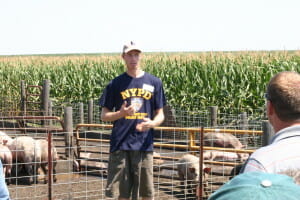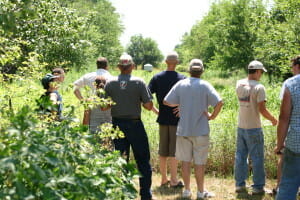Start-up Niche Pork: A Beginner’s First Year with Niman Ranch
Drew Lietz is a beginning farmer near Alta in northwest Iowa. He farms corn and beans on his own and with his family, and started producing for Niman Ranch in 2012. Drew is finishing his business plan to wrap-up his work in Practical Farmers’ Savings Incentive Program this winter.
In early 2012 I decided to try raising pigs for Niman Ranch, a company that buys and markets naturally raised pork. I first heard about Niman Ranch through some friends from Iowa State University. It was an opportunity to diversify and expand beyond my row crop income as a beginning farmer. 
The Niman Ranch program is all about raising pork the natural way, both for farrowing and market pig operations. Sows need to turn around in their pens and have access to the outdoors. Their genetics must be at least half white mothering breed, such as Chester White. Boars must be at least 50% a good meat producing breed, such as Duroc.
Niman Ranch animals must be fed an all vegetarian diet with no meat or bone meal of any kind. There are specific housing space and bedding requirements, and their tails cannot be docked. Antibiotic use is not allowed at any time. Niman Ranch asks you to raise your pigs to at least 260-280 lbs, and offers a per pound premium for it.
I’m blessed to say that a supportive Dad and existing on-farm resources helped me get started in niche pork. These included-
-
A barn with farrowing crates that had sat empty since 1998. Altering the crates to Niman standards was the biggest change needed;
-
An available farrowing pasture of 2-3 acres with shelter trees on two sides;
-
A silage bunker type building my Dad had used as a gestation pen;
-
Two Cargill open-front finishing buildings.
In April 2012 I bought a set of feeder pigs at about 20 lbs to finish in the Cargill units. I also bought a PTO feed grinder at a local auction.
In May 2012 I bought a set of 50 feeder gilts, with good mothering body structure, that were half Chester White and half mixed-breeds. They got unlimited feed until October, when I purchased five purebred Duroc boars. All my breeding stock came from Randy Schmidt, a Niman Ranch stock producer from Williamsburg, IA.
In late November I introduced the boars and gilts or a few weeks in the silage bunker. They were not in the same pen but had nose to nose contact through a fence. We bred them in mid-December. They were introduced two times daily with multiple opportunities for each gilt.
Those gilts farrowed in April 2013 and I am about to market their pigs now. That means my first farrow-to-finish cycle is almost done. I am also about to wean their second litter pigs that just farrowed in September.
My biggest challenges so far include sows laying on their pigs, coughing, and labor. With wide farrowing crates, sows are more likely to lay on piglets than narrow crates. My father used to farrow with narrow crates and he repeatedly speaks his mind on the difference.
I treat my pigs two times for mycoplasma, a respiratory disease, and 1 time for circovirus but I still have occasional coughing. I may try treating for mycoplasma three times in the future, but that will take more labor.
Pigs raised this way require plenty of labor so I’m fortunate to have my dad’s help. He helps with grinding feed, castrating, administering shots, cleaning pens and yards, loading and moving pigs around the farm and for market, and much more. He also gives considerable management expertise.

